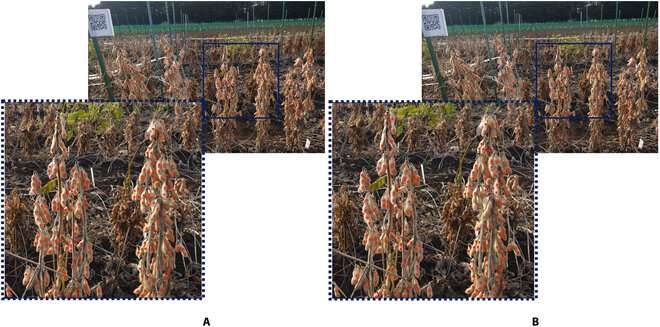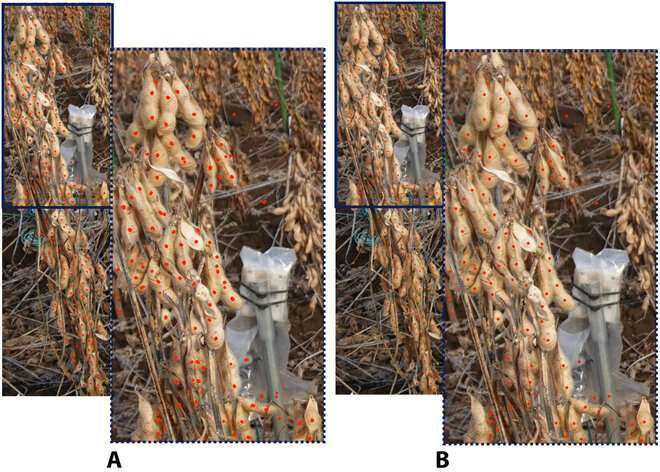Automated soybean seed counting: Grading existing methods for improved accuracy

Farming is one of the oldest activities in the world and has always been at the forefront of technological innovation. With mechanized equipment, modified seeds, and digital devices, every aspect of farming, from planting to harvesting is gradually getting optimized. These benefits have also translated to better crop yield estimation for crops such as soybean.
Deep learning-based yield estimation models use approaches like regression, traditional bounding boxes, or density maps to make counting of seeds easier. Compared to manual counting, these methods are undoubtedly simpler, more accurate, and easy to implement.
“P2PNet” is one such automated counting method which was recently proposed to simplify point counting of soybean seeds. However, this method demonstrated low performance for direct seed counting. Disturbance from background objects, substantial overpredictions, use of high-level features, and unaccounted scale of objects were identified as some drawbacks of this model.
To counter the challenges associated with this model, researchers from Japan have developed a new model that adds to the list of agricultural technological innovations. It accurately counts the number of soybean seeds from field images of soybean plants, eliminating the labor-intensive seed counting process.
The study was led by Associate Professor Wei Guo of the University of Tokyo and was published online in Plant Phenomics.
“Soybean is an important protein source for animals and humans. Therefore, achieving high crop yields is a common criterion and goal in most breeding programs,” explains Prof. Guo.
The seed count is of particular interest to farmers as it can be used to ascertain both, the plant’s yield and its breeding potential. Traditional image-based automated seed counting methods keep track of seeds in images by placing them in bounding boxes. However, in actual field conditions, the presence of complex backgrounds, overlapping pods, and varying lighting conditions can cause the bounding boxes to overlap, leading to inaccuracies in the seed count and position.

Addressing these challenges, the team upgraded P2PNet to the new, improved model “P2PNet-Soy”. It counts objects by identifying them as small points in the image. To obtain data for training the model for soybean seed identification, the researchers took 374 images of soybean plants grown in a field.
They photographed two sides (front and back) of the plant to capture maximum seeds in the plant. Next, skilled technicians from the Field Phenomics Lab at the University of Tokyo carefully marked the seeds present in each soybean pod with dots. They ensured that only the seeds belonging to the target plant were annotated and those from neighboring plants and the background were excluded. The researchers then selected 181 images for training and used the other 193 images, which were taken from the opposite side, to evaluate the model.
The researchers adopted several strategies to improve the performance of the model. First, both high- and low-level features were captured from the field images. The high-level features generally consider the context of the objects in the images, while the low-level features are much more useful in recognizing details and smaller objects.
A scale-invariant feature extraction method known as atrous convolution was then used to enable the model to detect seeds of different sizes. In addition, spatial and channel attention mechanisms were applied to better differentiate the seeds from the background. The research team refined the predictions of the model by applying a postprocessing technique called k-d tree, an unsupervised clustering algorithm that determines the centers of closely located predicted seed locations, boosting the accuracy of the final prediction.
These improvements resulted in an accurate seed counting and localization model that could detect and count seeds from simple images of soybean plants taken in the field. “The upgraded P2PNet-Soy method for more effective soybean seed counting and localization has much higher accuracy in comparison to not only the original P2PNet but also other soybean pod counting method,” says Prof. Guo.
Even as these improvements result in improved accuracy of seed prediction, the model has a few limitations which require redressal. Since the model is trained on images taken from both sides of the same plant, it can overestimate the number of seeds on the plant. Additionally, the model cannot detect seeds that are accidentally missed in the image.
Nevertheless, the development of such advanced technologies is a promising step towards a more efficient agricultural industry.
More information:
Jiangsan Zhao et al, Improved Field-Based Soybean Seed Counting and Localization with Feature Level Considered, Plant Phenomics (2023). DOI: 10.34133/plantphenomics.0026
Citation:
Automated soybean seed counting: Grading existing methods for improved accuracy (2023, April 26)
retrieved 26 April 2023
from https://phys.org/news/2023-04-automated-soybean-seed-grading-methods.html
This document is subject to copyright. Apart from any fair dealing for the purpose of private study or research, no
part may be reproduced without the written permission. The content is provided for information purposes only.
For all the latest Science News Click Here
For the latest news and updates, follow us on Google News.

